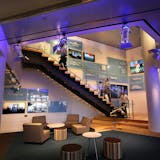Big changes lie just ahead at the elegant downtown St. Paul library that recently acquired the good name George Latimer. On Oct. 5, it will close for about eight weeks of remodeling to make the interior of the 98-year-old Italianate palace better suited to its 21st-century role.
Today, libraries are not primarily repositories of books. They are centers for learning for all comers, employing a rich variety of learning tools.
Regrettably, on Oct. 2, a leader in advancing that idea will step down. Kit Hadley is retiring as director of the St. Paul Public Library after six fruitful years. Hadley's credits also include eight years as head of the Minnesota Housing Finance Agency and four years as director of the Minneapolis Public Library. At the latter post, she was instrumental in executing a merger with the Hennepin County Library that averted the otherwise-likely downsizing and closure of one or more Minneapolis branches.
Hadley's service in St. Paul did not require a similar rescue mission. But the facilities she found in 2009 were showing their age. They were designed for a day when learning typically meant acquiring and quietly reading books. Libraries aren't quiet anymore, and books, while still important, aren't as dominant.
On Hadley's watch, the system's physical spaces were transformed. Complete renovations were made at Highland Park and Sun Ray. Less sweeping adaptations came to Merriam Park, Rice Street, Rondo, St. Anthony Park, Hayden Heights and West Seventh. In various places, flexible individual study rooms and community meeting rooms were added. Children's spaces were redesigned for interactive storytelling and creative play. Seating was configured to allow patrons to use and recharge their electronic devices. Computers were positioned for easy access to staffers who can coach patrons on their use. Materials handling was automated.
Hadley also helped engineer a new blend of services — libraries plus parks — at Arlington Hills Community Center. It offers a major asset to its working-class neighborhood — an after-work place where people can come to stretch both their muscles and their minds and to connect with each other.
When work is completed late this year at George Latimer Central Library, Hadley said, the renewal of the St. Paul system's physical plant for the modern era will be complete. For that, she credits both St. Paul taxpayers and the generosity of donors to the Friends of the St. Paul Public Library, whose capital campaign has raised more than $7 million.
Another transformation — in public understanding — ought to come in its wake. Those who think that the online revolution has made public libraries obsolete are missing the fact that libraries have always been, first and foremost, about learning. They are needed — and used — more than ever.



